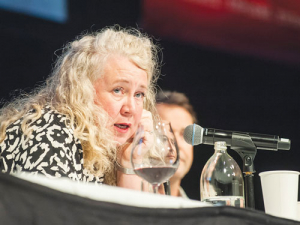At the Aromatics Symposium held in Nelson, Jane Skilton MW said these labels are a golden opportunity to tell the consumer a story, rather than provide a “weird food and wine match”, or a rundown on brix and pH levels.
“Why not tell the consumer something useful, like what does the wine taste like. Not in a pretentious way, but tell them something like; we have left some sweetness in the wine because we think this is better balanced.
Or this is a drier style of wine because we think it works particularly well in this vintage. Tell the consumer something they can use. They are already confused, they feel hesitant. Wine has this incredible ability to make people feel embaressed.”
Skilton and Nick Nobilo led the Masterclass on Gewurztraminer at the Symposium, where three flights of wine, in three different styles were tasted.
The first flight was considered dry (ish), the second off dry (ish) and the third, sweet (ish).
Skilton said there has been a lot of talk about why Gewurztraminer is a hard sell to consumers, but she believes much of that relates to confusing messages on the bottle itself.
“If you continue to write back labels in that hideous mumbo jumbo, that nobody can understand, then it’s no wonder you can’t sell your wine. We do not want a whole lot of Tolstoy prose on the back that nobody can understand. If you told everybody how sweet it was or it has a taste that we can recognise, it might be alright.”
The debate over what determines dry, versus off dry and sweet is a reoccurring one. And it was one that garnered a lot of discussion during the Symposium. Skilton feels that a simple numbering system is one way that could help lift aromatic wines out of the doldrums, in terms of consumer preference. She said a number of own brand supermarket wines in the UK are already utilising a system that rates the sweetness of a wine by numbers between one and nine.
“You might think a wine is a four, and I might think it is a five. But you won’t get one person saying a wine is a two while others think it is a nine. You will find the range you like and will know what to look for when picking up a bottle.”
One question put to both Skilton and Nobilo was whether people are embarrassed to acknowledge they like sweet wines, which Skilton says is ridiculous.
“When was the last time you heard someone say they were scared of sweetness, especially when we are drowning in sugar. People will have ice creams, cakes, brownies. Nobody says they don’t want to eat those things because they are sweet.
“But in wine there is such a lot of perceived opinion. I would love to know exactly when was the last time anyone did research into what consumers believe. I think we are told that people don’t like this or that, without anyone actually asking them.”
Sommeliers and those producing wine lists may also to be to blame for a number of aromatics failing to grab consumer attention. Skilton says go into any restaurant or bar, and the list for Sauvignon Blanc, Chardonnay and Pinot Noir is likely to be extensive.
“Then there is this licorice allsorts at the back. One Gewurztraminer, one Albarino, one this or that. People say why is there only one of them? By the sheer numbers it must look as though Sauvignon and Chardonnay are much better.
“I know I am not running a restaurant, but to me it is like someone has wanted to have a few unusual wines on the list to make it look more rounded. But to me that is sweeping up.”
There was no way the 55 attending the Aromatics Symposium in Nelson didn’t know how much more New Zealand has to offer in this category. Besides the Gewurztraminer Master Class, the guests were treated to three flights of Riesling, led by Andrew Hedley and Bob Campbell MW, a Pinot Gris class led by Dom Maxwell and Emma Jenkins MW, and a smaller plantings class led by Simon Nunns and Stephen Wong MW.










